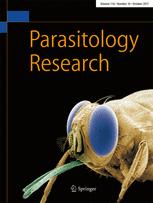Molecular characterization of triosephosphate isomerase fromEchinococcus granulosus
Maodi Wu , Min Yan , Jing Xu,Xiaoxiao Yin , Xiaowei Dong , Ning Wang , Xiaobin Gu , Yue Xie ,
Weimin Lai , Bo Jing , Xuerong Peng , Guangyou Yang

Abstract
Cystic echinococcosis (CE) is a zoonosis that can be caused by the larvae ofEchinococcus granulosus; this disease occurs worldwide and is highly endemic in China.E.granulosuscan produce energy by glycolysis as well as both aerobic and anaerobic respirations. Triosephosphate isomerase is a glycolytic enzyme present in a wide range of organisms and plays an important role in glycolysis. However, there has been little research on triosephosphate isomerase fromE.granulosus(Eg-TIM). Here, we present a bioinformatic characterization and the experimentally determined tissue distribution characteristics of Eg-TIM. We also explored its potential value for diagnosing CE in sheep using indirect enzyme-linked immunosorbent assay (ELISA). Native Eg-TIM was located in the neck and hooks of protoscoleces (PSCs), as well as the tegument and parenchyma tissue of adult worms. The entire germinal layer was also Eg-TIM positive. Western blots showed that recombinant Eg-TIM (rEg-TIM) reacts with positive serum from sheep and had good immunogenicity. Indirect ELISA exhibited low specificity (53.6%) and low sensitivity (87.5%) and crossreacted with bothTaenia multicepsandTaenia hydatigena. Our results suggest that TIM may take part in the growth and development ofE.granulosus. Furthermore, we determined that rEg-TIM is not a suitable serodiagnostic antigen for CE in sheep.
copyright:© Springer-Verlag GmbH Germany, part of Springer Nature 2018.
Parasitol Res (2018). doi.org/10.1007/s00436-018-6015-3
Read Full Text: https://doi.org/10.1007/s00436-018-6015-3